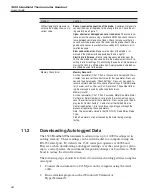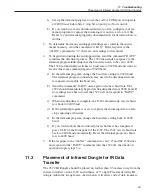
Problem
Solution
While attempting to measure re-
sistance the display shows an in-
correct value.
Poor or incorrect connection of the probe.
A common mistake is to
connect the wires of the probe to the wrong terminals. Check the wir-
ing carefully (see Figure 7).
Open, shorted, or damaged sensor or lead wires.
Check the resis-
tance across the sensor using a handheld DMM. Also check the resis-
tance between common pairs of leads. Check to make sure there is
no conductivity between any of the leads and the probe sheath. Use a
good-quality sensor to avoid errors caused by drift, hysteresis, or in-
sulation leakage.
Stem conduction error.
Make sure the stem of the probe is im-
mersed in the medium with adequate depth and a tight fit.
Electrical interference.
Intense radio-frequency radiation near the
1522 or the probe can induce noise into the measurement circuits re-
sulting in erratic readings. Try eliminating the source of interference or
moving the 1522 to a different location. A well-grounded, shielded ca-
ble should be used for the probe.
Memory Check Error
Memory Recover X.
A critical parameter (CAL1, CAL2, or Passcode) is corrupt and the in-
strument can recover the correct value for that parameter. Press any
key and the display reads “Check Settings”. Press any key again to
resume normal operation. Also, check other settings in the thermome-
ter (if used), such as, filter, units, and resolution. The number follow-
ing the message is used by authorized technicians.
Memory Invalid!
A critical parameter (CAL1, CAL2, Passcode, Meter Due Date, Meter
Cal Date, or Serial Number) is corrupt and the instrument cannot re-
cover the correct value for that parameter. Press any key and the dis-
play reads “Contact Factory”. Contact a Hart Authorized Service
Center (see Section 1.3) for assistance in guiding you through the
process of reentering these parameters.
Note: The parameters stored in the INFO-CON, Probe Wires, Probe
Type,
Probe Parameters, are not checked by the meter during memory
testing.
11.2
Downloading Autologged Data
The 1522 Handheld Thermometer readout stores up to 10,000 readings in its
autolog memory. These readings can be downloaded to a computer using the
RS-232 serial port. By default, the 1522 serial port operates at 2400 baud.
However, when downloading autologged readings over the serial port or print-
ing to a serial printer, the instrument temporarily changes its baud rate to 9600
baud to reduce the download time.
The following steps should be followed to download autologged data using the
serial port:
1.
Connect the instrument to a COM port on the computer using the serial
cable.
2.
Run a terminal program such as Windows® Terminal or
HyperTerminal®.
1522 Handheld Thermometer Readout
User’s Guide
58




































